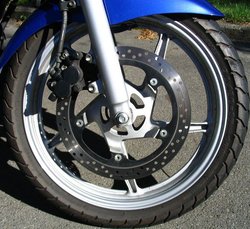Brake
A brake is a device for slowing or stopping the motion of a machine or vehicle, or alternatively a device to restrain it from starting to move again. The kinetic energy lost by the moving part is usually translated to heat by friction. Alternatively, in regenerative braking, much of the energy is recovered and stored in a flywheel, capacitor or turned into alternating current by an alternator, then rectified and stored in a battery for later use.
Note that kinetic energy increases with the square of the velocity (E = ½m·v2 relationship). This means that if the speed of a vehicle doubles, it has four times as much energy. The brakes must therefore dissipate four times as much energy to stop it and consequently the braking distance is four times as long.
Brakes of some description are fitted to most wheeled vehicles, including automobiles of all kinds, trucks, trains, motorcycles, and bicycles. Baggage carts and shopping carts may have them for use on a moving ramp.
Some aeroplanes are fitted with wheel brakes on the undercarriage. Some aircraft also feature air brakes designed to slow them down in flight. Notable examples include gliders and some WWII-era fighter aircraft. These allow the aircraft to maintain a safe speed in a steep descent. The Saab B 17 dive bomber used the deployed undercarriage as an air brake.
Deceleration and avoiding acceleration when going downhill can also be achieved by using a low gear; see engine braking.
Friction brakes on cars store the heat in the rotating part (drum brake or disc brake) during the brake application and release it to the air gradually.
See also
- Archaic past tense of break (see brake)
- Air brake (road vehicle)
- Air brake (rail)
- Air brake (aircraft)
- Brake (railway)
- Brake-by-wire (or electromechanical braking)
- Bicycle brake systems
- Bundy tube
- Disc brake
- Drum brake
- Electromagnetic brake
- Engine braking
- Hydraulic brake
- Jake brake also known as J braking
- Threshold braking
- Trail braking
- Regenerative braking
- Vehicle brake
- Brake Forming
